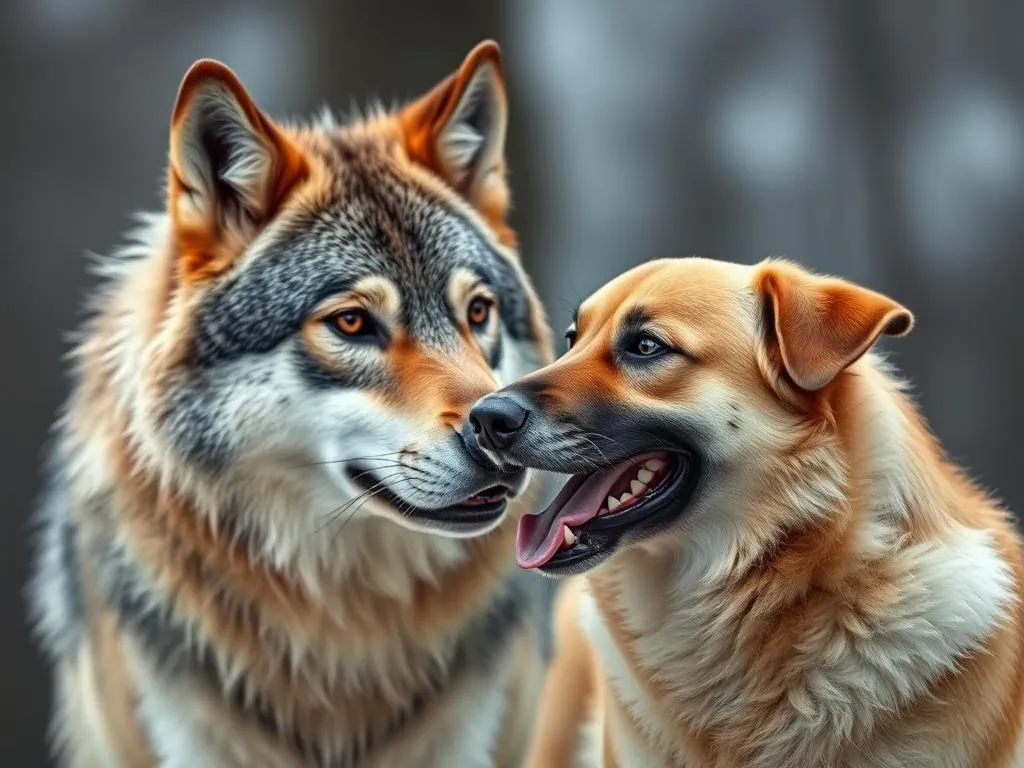
Introduction
When we think about wolves and dogs, we often picture two very different animals—one wild and fierce, the other domesticated and friendly. But what exactly constitutes a wolf and a dog? Wolves are large, social carnivores that roam in packs, primarily inhabiting wilderness areas around the globe. On the other hand, dogs (Canis lupus familiaris) are descendants of wolves, having been domesticated by humans thousands of years ago.
This article aims to explore the fascinating comparison between these two species, delving into their evolutionary backgrounds, physical characteristics, behavioral traits, and lifestyle differences. Understanding these distinctions is not just an academic exercise; it has real implications for pet owners, wildlife conservationists, and anyone interested in animal behavior.
Evolutionary Background
Origins of Dogs
The domestication of dogs is a significant milestone in human history, dating back around 15,000 to 40,000 years. Early humans likely began to domesticate wolves for their hunting abilities and companionship. Over generations, selective breeding led to the emergence of various dog breeds, each adapted for specific tasks such as herding, hunting, and guarding.
Genetic Differences
At the genetic level, the differences between wolves and dogs are striking yet subtle. While they share about 98.8% of their DNA, the small percentage that separates them accounts for significant behavioral and physical variations. For instance, dogs have a more varied coat color and size, which are adaptations resulting from selective breeding by humans.
Behavioral Evolution
The transition from wolf to dog involved substantial changes in behavior. Wolves exhibit strong social structures centered around pack dynamics, where hunting is a collective effort. In contrast, dogs have adapted to human companionship, leading to changes in their social behaviors, such as increased affection and loyalty towards humans. This shift illustrates the profound influence that human interaction has had on the evolution of canine behavior.
Physical Differences
Size and Structure
One of the most noticeable differences between wolves and dogs is their size. Wolves are generally larger, with adult males weighing between 70 to 110 pounds, while dogs vary widely in size based on their breed. For example, a Great Dane can weigh as much as 175 pounds, while a Chihuahua may only weigh around 5 pounds.
Coat and Color
The coat of a wolf is typically dense and coarse, designed for insulation in cold climates. Wolves generally have a natural color palette of grays, browns, and blacks. In contrast, dog breeds exhibit an extensive range of fur types, colors, and patterns, from the long, silky fur of a Afghan Hound to the short, smooth coat of a Beagle.
Sensory Abilities
Both wolves and dogs possess exceptional sensory abilities, but there are differences in their capabilities. Wolves have a superior sense of smell, estimated to be 100 times more sensitive than that of humans, allowing them to hunt effectively. Dogs, while also having a keen sense of smell, are more attuned to human cues, making them excellent companions and working animals.
Behavioral Traits
Social Structure and Pack Dynamics
In the wild, wolves operate within structured social groups known as packs. These packs are typically family units, with a clear hierarchy that dictates roles and responsibilities. Conversely, dogs have adapted their social structures to coexist with humans, often viewing their owners as the pack leaders. This shift alters their social dynamics significantly, leading to different interaction styles with both humans and other animals.
Communication Styles
Communication is another area where wolves and dogs diverge. Wolves communicate through a combination of vocalizations, body language, and scent marking to convey messages to their pack. Dogs, however, have developed unique vocalizations and body language to communicate effectively with humans. Understanding these communication styles can enhance the bond between dogs and their owners.
Training and Intelligence
Both wolves and dogs exhibit intelligence, but their trainability differs considerably. While wolves are intelligent, their independent nature makes them challenging to train. Dogs, on the other hand, are generally more eager to please and respond well to training. This trait has led to the development of various roles for dogs in human society, including service and therapy animals.
Lifestyle and Habitat
Natural Habitat
Wolves thrive in a variety of natural habitats, including forests, tundras, and grasslands. They require large territories for hunting and socializing. In contrast, dogs live in diverse environments, primarily within human homes, where they adapt to indoor lifestyles or backyards. This significant difference in habitat shapes their daily activities and social interactions.
Dietary Needs
Wolves are obligate carnivores, primarily hunting large prey to meet their dietary needs. They consume a raw diet rich in proteins and fats, reflecting their evolutionary adaptations. Dogs, however, are more omnivorous, with a diet that often includes processed foods designed for their health and nutritional needs. This shift in diet has implications for their physical health and behavior.
Exercise and Activity Levels
In terms of exercise, wolves require a significant amount of physical activity to maintain their health and social structure, often covering large distances in search of food. Dogs, depending on their breed and age, also need regular exercise, but the intensity and duration can vary widely. For example, a Border Collie may need several hours of vigorous exercise daily, while a Bulldog may be content with short walks.
Human Interaction
Role of Dogs in Human Society
Dogs play a multifaceted role in human society, serving as companions, working animals, and even therapeutic aids. From service dogs assisting individuals with disabilities to therapy dogs providing comfort in hospitals, the bond between humans and dogs is profound and beneficial.
Wolves and Human Perception
Wolves often suffer from negative perceptions fueled by myths and misconceptions. Many view them as dangerous predators, failing to recognize their ecological importance as apex predators that help maintain balanced ecosystems. Understanding wolves is crucial to fostering coexistence and appreciation for these majestic creatures.
Conservation Efforts for Wolves
The preservation of wolf populations is vital for maintaining biodiversity and ecosystem health. Conservation efforts focus on protecting natural habitats, mitigating human-wildlife conflicts, and promoting understanding and coexistence. Supporting these initiatives can contribute to the survival of these incredible animals.
Myths and Misconceptions
Common Misunderstandings about Wolves
Misunderstandings about wolves often stem from cultural portrayals as villains in folklore and media. Many believe that wolves are inherently dangerous or untrainable, overlooking their complex social structures and ecological roles. Educating the public about the true nature of wolves is essential for conservation efforts.
Misconceptions about Dogs
Similarly, misconceptions about dogs can lead to poor treatment or misunderstanding of their behaviors. For example, the belief that a wagging tail always signifies happiness is misleading; dogs may wag their tails for various reasons, including excitement, anxiety, or aggression. Understanding these nuances is crucial for responsible pet ownership.
Conclusion
In summary, the comparison of wolves and dogs reveals a complex relationship shaped by evolution, behavior, and human interaction. While they share a common ancestry, the differences between these two species are profound, affecting their physical traits, social structures, and lifestyles.
Understanding these distinctions is vital not only for dog owners but also for those interested in wildlife conservation. By appreciating the intricate lives of both wolves and dogs, we can foster a deeper connection to our pets and the natural world around us.
Recognizing the importance of responsible pet ownership and advocating for the preservation of wild wolves are steps we can all take towards a harmonious coexistence with these remarkable creatures.









